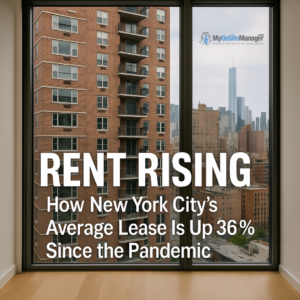New York City has long been synonymous with sky-high rents, but the current figures are startling even by NYC standards.
According to new data from Zillow and StreetEasy, the average asking rent in New York City has surged 36% since before the pandemic, making it one of the fastest-rising markets in the country.
The median asking rent now hovers around $3,800 a figure that continues to push the limits of affordability for many residents. For comparison, in 2019, median rents were closer to $2,800–$2,900. That’s a $900–$1,000 jump in just a few years far outpacing wage growth or inflation.
Rent Growth Outpacing Wages Sevenfold
The most striking part of the report isn’t just the increase it’s how rapidly rents have grown compared to earnings.
Zillow’s research shows that in the past year, rents have grown seven times faster than wages. This widening gap highlights one of the city’s most pressing affordability crises in decades.
As rental costs climb, many working-class New Yorkers find themselves forced to compromise downsizing, taking on roommates, or moving to outer boroughs to make ends meet. Even traditionally “affordable” neighborhoods have seen steep hikes.
The Borough Breakdown: Queens Leads the Surge
Among all boroughs, Queens saw one of the steepest jumps 9% higher rents year-over-year, driven by rising demand and shrinking availability.
Brooklyn and Manhattan also remain hot zones for competition, particularly as remote work trends fade and more professionals return to the city full-time.
The shortage of new housing supply continues to fuel this surge. Analysts estimate that the U.S. housing market faces a shortage of nearly 389,000 units, and New York’s tight zoning rules and lengthy permitting processes only add to the squeeze.
Why Is This Happening?
The reasons behind New York’s relentless rent growth are complex but interconnected:
-
Post-pandemic rebound – Many renters who left during 2020 and 2021 have returned, reigniting competition in key neighborhoods.
-
Chronic housing shortage – Construction hasn’t kept pace with population recovery, leaving fewer units available.
-
Inflation and high interest rates – With homeownership becoming less attainable, more people are staying renters longer.
-
Wage stagnation – While the cost of living surges, wage growth has failed to keep up, compounding affordability issues.
-
Seasonal cycles – The rental market typically cools during winter months, but in New York, even “slow” seasons now show elevated pricing.
As StreetEasy’s consumer trends expert Kenny Lee notes:
“Renter competition has softened this year, and we’re starting to head into the colder months, which is when rents in the city tend to be at their lowest.”
This seasonal slowdown may offer a narrow window of opportunity for those hoping to lock in more manageable leases.
Timing Matters More Than Ever
Timing your lease renewal or apartment search could mean the difference between paying thousands more or saving a few hundred dollars monthly.
Historically, the spring months (April–May) see higher competition and pricing as people prepare for summer moves.
But the TimeOut article notes that renters looking for slightly lower prices might find better luck in April rather than May, as the market’s pricing peaks appear to be shifting earlier in the year.
What It Means for Renters
For tenants navigating this market, the numbers can feel discouraging but strategy and timing can still make a difference.
-
Start early: Begin your apartment search two to three months before your current lease ends.
-
Be flexible: Expanding your search to outer boroughs like the Bronx or Staten Island could unlock better deals.
-
Negotiate renewals: Some landlords may be willing to offer smaller increases to retain reliable tenants during off-peak months.
-
Track market cycles: If possible, plan moves during late fall or winter when demand is historically lower.
The rental market may not offer easy relief, but informed decision-making remains renters’ strongest tool.
What It Means for Property Managers and Landlords
For property professionals and onsite managers, New York’s trends signal the need for strategic adaptability.
-
Tenant retention is key: As rents climb, residents are more sensitive to customer service, maintenance speed, and perceived value.
-
Communicate value: Explain the reasons behind price adjustments and emphasize amenities, upgrades, or community benefits.
-
Monitor market data: Track competitor listings in your area to stay competitively priced without overextending tenants.
-
Plan for seasonality: Use slower months (December–February) to focus on property improvements or marketing to attract early movers.
These trends mirror what’s happening nationwide where housing demand remains strong but affordability continues to decline.
The Bigger Picture: A Reflection of the National Housing Crisis
New York City’s rent surge isn’t happening in isolation. Across the U.S., metro areas from Miami to Los Angeles are experiencing similar post-pandemic spikes.
However, New York’s mix of limited space, strict zoning, and sustained demand makes it a particularly vivid case study of how structural housing shortages can drive long-term affordability issues.
Without significant investment in housing construction or new affordability policies, renters will likely continue to face record-high costs.
Final Thoughts
New York City remains one of the world’s most desirable places to live but increasingly, only for those who can afford it.
A 36% jump in just five years underscores the fragility of rental affordability in major cities and the urgent need for long-term housing solutions.
For now, renters should stay informed, time their moves wisely, and advocate for transparency in rental pricing.
And for landlords and property managers, this environment highlights the value of empathy, strategy, and open communication in maintaining strong tenant relationships amid a challenging market.

